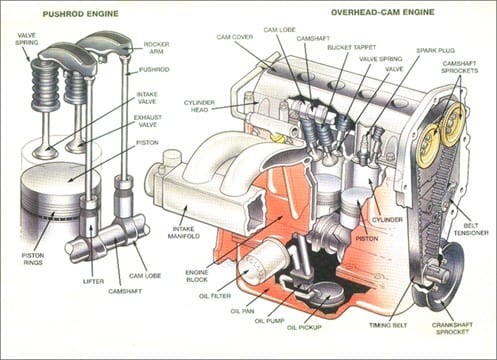Just like the human body relies on a skeleton for structure and support, a car engine depends on the engine block, often referred to as the cylinder block, as its foundational component. If you’re getting to grips with car mechanics, you might be wondering about the different parts and their roles. A common question that arises is: is a cylinder block a moving part in a car? Let’s delve into the heart of your engine to understand the cylinder block and its function within the intricate system that powers your vehicle.
To answer the question directly, the cylinder block is not a moving part. It’s the robust, stationary foundation upon which many of the engine’s moving parts are mounted and operate. Think of it as the main housing for the engine’s cylinders and other crucial components. Modern cars commonly feature engines with four to eight cylinders, and the cylinder block is engineered with precision to accommodate these, along with the intricate pathways for coolant and oil that keep the engine running smoothly.
What Exactly is a Cylinder Block?
The cylinder block is the core structure of your engine. Typically crafted from aluminum or iron for durability and strength, it’s designed with multiple cylindrical cavities – these are the cylinders themselves. Beyond just housing the cylinders, the engine block serves several vital functions:
- Cylinder Housing: As the name suggests, it’s the primary housing for the engine cylinders where combustion takes place.
- Coolant Passageways: The block contains precisely engineered channels for coolant to circulate, dissipating heat and preventing the engine from overheating. These water flow paths are generally wider to facilitate efficient cooling.
- Oil Passageways: It also includes narrower pathways for engine oil to lubricate the numerous moving parts within and around the block, reducing friction and wear.
- Structural Support: The engine block provides a rigid structure that supports and aligns other critical engine components like the crankshaft, pistons, and camshaft.
Essentially, the cylinder block is the non-moving backbone of your engine, designed to withstand immense pressures and temperatures while providing a stable environment for the engine’s dynamic components to operate.
Moving Parts Within and Around the Cylinder Block
While the cylinder block itself remains stationary, it’s crucial to understand the moving parts that operate within and in close relation to it. These parts are responsible for converting fuel energy into the motion that drives your car.
- Pistons: These cylindrical components move rapidly up and down inside the cylinders of the engine block. The pistons are directly driven by the combustion of fuel, and they, in turn, transfer this force to the crankshaft. Piston rings are essential components fitted to the pistons to ensure proper compression and minimize friction against the cylinder walls.
- Crankshaft: Located at the lower part of the engine block, the crankshaft is a rotating shaft that converts the linear motion of the pistons into rotational motion. This rotational force is what ultimately powers your vehicle’s wheels. The crankshaft is supported by crankshaft journals and connected to the pistons via connecting rods.
- Camshaft: The camshaft, which can be situated in the engine block or cylinder head (often in modern engines as a Dual Overhead Camshaft or Single Overhead Camshaft configuration), is responsible for controlling the timing of the engine’s valves. It synchronizes with the crankshaft, ensuring that the intake and exhaust valves open and close at precisely the right moments for optimal engine performance.
- Cylinder Head: Attached atop the engine block with cylinder bolts and sealed by a head gasket, the cylinder head is another stationary component, but it’s integral to the engine’s operation. It houses valves, valve springs, lifters, pushrods, rockers, and sometimes camshafts. The cylinder head manages the flow of air and fuel into the cylinders and the expulsion of exhaust gases.
- Timing Belt/Chain: While not directly inside the block, the timing belt or chain is critical for synchronizing the rotation of the camshaft and crankshaft. This synchronization is vital for the correct timing of all engine processes.
Common Issues Related to the Cylinder Block
Although the cylinder block is a robust component, it can experience problems over time, often due to extreme stress or lack of maintenance. Some common issues include:
- Cracked Engine Block: Overheating or severe stress can lead to cracks in the engine block. This can result in coolant leaks, overheating, and white smoke from the exhaust.
- Damage to Cylinders: The cylinder walls within the block can become scored or damaged due to piston ring failure or debris. This can lead to poor compression, blue smoke from the exhaust, and reduced engine performance.
These types of engine block issues are serious and typically require professional attention.
Maintaining Engine Health
To ensure the longevity of your engine, including the cylinder block and all its related components, regular maintenance is essential. Key maintenance tasks include:
- Regular Oil Changes: Fresh engine oil is crucial for lubricating all the moving parts and preventing wear within the engine block.
- Coolant Flushes: Maintaining a clean and effective coolant system prevents overheating, which can stress the cylinder block.
- Timing Belt/Chain Replacement: Following the manufacturer’s recommended intervals for timing belt or chain replacement is vital to prevent catastrophic engine failure.
Understanding the role of the cylinder block – and knowing that it is indeed a stationary, not a moving, part – is a fundamental step in grasping how your car engine operates. For expert care and maintenance of your engine, trust qualified professionals to ensure your vehicle runs smoothly and reliably for years to come.
